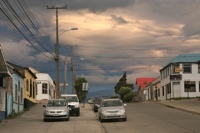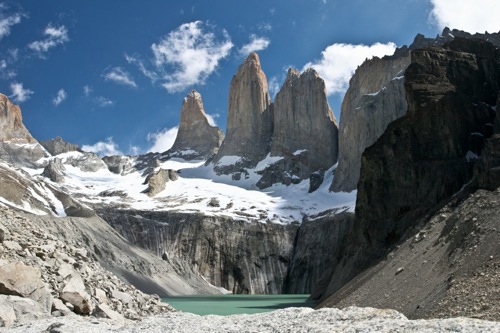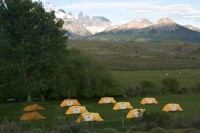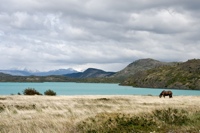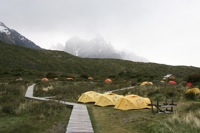Part 4: Torres del Paine National Park
| |
|
On the morning of day six, we left the Cauquenes and took a bunch of taxis, again trendy beats blaring, down the still quiet streets of Calafate to the bus station for our long ride across the border and into Puerto Natales, Chile, our launching pad for Torres del Paine and Gem's home. We were warned to consume all fruits and nuts before reaching the Chilean border because our bags would most likely be X-rayed, and it was inadvisable to be found in possession. Apparently, Chile is rather stringent with its fruit policy — as though fruits and nuts are insidious weapons of mass destruction and a threat to its national security. The bus, a newish model Merc, was comfortable and had a nice, smooth ride, that is until about two hours after we left the station, when without warning, the driver made a sharp right turn onto an unpaved road, and we abandoned the comforts of good ol' Route 40. The border crossing is actually a mile or two across with the Argentinian passport control on one side and the Chilean on the other, and everything in between appears to be no-man's land. At the first checkpoint we all got off the bus and handed over our passports in one big pile to get them exit stamped and waited, waited for what seemed like an eternity. That's one of the mysteries of South America. You often find yourself in situations where you are forced to wait for long periods of time for no apparent reason. The informative pamphlets from Gap Adventures had good advice for such situations, however: “embrace the bizarre.” And embrace the bizarre, we did. Some of us used the time wisely and offered our extra apples to the wild horses hanging around the check point who were more than happy to take them off our hands. On the Chilean side, our bags did get X-rayed, but fortunately they didn't ransack the bus and an hour later we continued on to Puerto Natales. |
Outline» Buenos Aires» El Chaltén and Mt. Fitz Roy » El Calafate and Perito Moreno » Torres del Paine NP » Punta Arenas and the Penguins » Ushuaia: Fin del Mundo
|
|
Puerto NatalesPuerto Natales is a small harbor town of about 20 thousand and is situated on the east shore of Ultima Esperanza Sound (Last Hope Sound). The sound gets its name from the early explorers who were navigating the maze of fjords in the area looking for a passage to the Atlantic. Instead they ended up in the cul-de-sac of Ultima Esperanza and a town sprung up. We arrived here in the early afternoon in time for a late lunch. Tired of the heavy meat and carb diet of Argentina (think steak, pasta, and empanadas), we were eager to try the local fish in this coastal town. For seafood, Gem recommended Angelicas, and Angelicas delivered. I ordered the merluza, which is a local sea bass with delicate white meat, and the chef/owner cooked it to perfection. The meal set me back 8,000. Pesos. At 500 to 1, that's only about 16 USD, but the Chilean currency carries way too many zeros, which makes posted prices hard to parse. They could easily chop off two zeros off the bills as the need for that level of precision never arises in everyday transactions. After lunch we explored the shops and little side streets, admiring the colorful houses and their elaborate door and door knob designs. Door knobs in this and other Chilean towns, are oddly placed in the center of the doors, like the little hobbit doors in the Lord of the Rings. Doors also oddly open inwards, even at shops and restaurants, which took a little getting used to. The stray dogs here are many but very docile and full of personality. It's not uncommon to pass them by on the sidewalk as they trot along purposefully to who knows where. Probably as a consequence, household garbage is stowed on elevated metal poles to keep them out of their way. Overall, Puerto Natales has a nice small town feel as evidenced by us running into Gem twice in two hours. At dusk, the skies take on brilliant colors as if trying to compete with the houses below. Torres del Paine |
|
|
The trouble with Chile is that it has absolutely no appreciation for good coffee. Nescafé passes off as a good cup and is the best you can hope for at most restaurants. Foreigners jokingly call the powder No Es Café and are absolutely correct. Day seven, therefore, did not start off right, but those of us who rely on caffeine to get us going in the morning saw this deficiency as good preparation for the certain lack of luxuries to be expected while camping the next two nights. After breakfast we hopped on another minibus and headed north towards Torres del Paine National Park, making a quick stop at the border crossing town in hopes of finding some real coffee. The park entrance is accessed by about 25km of unpaved road with distance markers oddly placed every 100m and sometimes even every 20m, giving an immediate answer to potential “are we there yet?” questions. Along the way we came across numerous guanacos grazing sometimes solo but mostly in pairs. Guanacos are a member of the camel family of South America along with the llama, alpaca, and vicuna. Their only real natural predator is the puma, but these lucky guanacos that have chosen to settle around Torres del Paine are relatively safe from harm as the puma doesn't venture this far, probably for lack of good cover. Consequently, the guanacos numbers have grown and the Chilean government has even considered promoting hunting to control their numbers. The trouble is the guanaco doesn't taste any good. We tried some in the form of a stew in Punta Arenas, and I share the locals' sentiment — I'd pick lamb or beef any day over it. At the park entrance we got our first real glimpse of the Torres. It was beautiful and sunny and aside from the wind, a spectacular day for hiking up to the top. There was only one minor obstacle at the entrance. The wooden bridge over the river was not rated to take on the full weight of the minibus and all of us on board. We had to disembark temporarily and wait on the other side for the driver to maneuver the vehicle through the narrow space. 


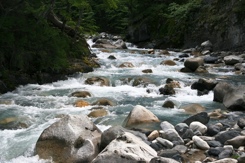
Gem warned us that today's hike would be strenuous, perhaps the most strenuous of the tour, especially towards the end. We would cover a distance of almost 11 miles with an elevation gain of 2,700 feet. Because there were too many of us for Gem to keep an eye on at all times, Gap hired a local as a sweeper, who would hike just behind the last person and be in communication with Gem in the front over walkie talkie. For some of us, stopping every five minutes for the stragglers to catch up was too much to bear, so we broke from the group and continued at our own pace, an action we were scolded for at the top. But in our defense, we could see the Torres were free of clouds, and not knowing how long that could possibly last, we thought it prudent to make it there sooner rather than later. 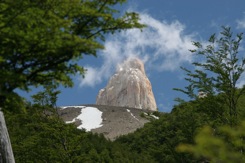

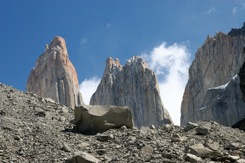

Indeed, it turned out to be a good decision, because just as we reached the top, a large group was turning around and left us in peace and quiet to admire the Torres. And by the time the rest of our group made it, nearly an hour later, it started snowing. My Canon 24-105mm L lens is insufficiently wide angle to capture the immense scene, so the photo you see below is actually stitched together from a dozen individual photos.
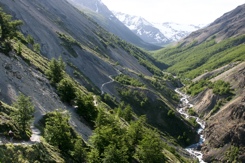

|
|
|
On the way back, we asked Gem what would be for dinner. The physical exertion had left us famished. In his usual jocular way, he answered with: “just rice. You like rice?” In our state we were willing to eat anything, even guanaco, but when we made it to the camp site we were unprepared for what awaited us. Gap, through the company Gem works for, rents a small piece of land from a farmer whose property is just a mile from the park entrance and blessed with a brilliant view of the Torres. On this parcel of land, the camp site consists of two permanent structures: bathrooms fitted with (sometimes warm) showers and a shanty that's divided diagonally into a kitchen and dining area. There is also a giant relaxation tent equipped with beanbags to rest one's weary legs after the hike. When we arrived, our tents had already been pitched, and mouthwatering scents were drifting toward us from the cabin. We each staked a claim to a tent, and exhausted, sprawled out on the beanbags in the relaxation tent. And then began the feast. Coté, the incredibly charming and gifted chef, greeted us with pisco sour served in glasses primed with a sugar coating on the edges, and delicious fresh baked bread, cheese spreads, meats, and guacamole. Her attention to detail was impeccable — not only in her cooking but also in the decor. She had decorated the dining area with her own paintings and even fitted the bathrooms with live mint. The appetizers gave us enough energy to relocate from the relaxation tent to the dining area. First came the warming yam soup, for which Coté apologized unnecessarily (her mixer broke!), salad, then grilled salmon and quinoa (Gem was half right about the rice), and chocolate mocha cream dessert to top it all off. That she is able to create these culinary delights in such a remote location is truly amazing. Oh, and we even got a real cup of coffee after dessert. This was camping at its most luxurious. |
|
|
Unlike hotel rooms, tents carry sound easily, and it was amusing to overhear others discovering the neat little features of our North Face tents one by one. “Oh, cool, these are glow in the dark zippers!” “Man, this sleeping bag is super warm.” Indeed, the sleeping bags were warm. Rated at -20, they kept us very comfortable, and we slept soundly. I wanted to catch the early morning colors on the Torres and so set my alarm for 4:45am. Nicole had expressed interest in joining me but when I finally managed to wake her up, she deemed it too cold to go out. I got my camera and tripod and headed for a better vantage paint, leaving a cacophony of snoring behind. As I made my way to the main road I unsettled the farmer's flock of 30 or 40 sheep who were not expecting company before sunrise. They quickly forgot about me and went back to sleep. At my chosen spot, I waited for the sun's rays, shivering and doing jumping jacks in an effort to maintain feeling in my hands. The Torres were unobstructed by clouds, but yonder east, the sun rose behind thick clouds and the whole exercise was all for naught. Back at the camp site, a few early risers were stirring and the sweet smell of coffee was already radiating from Coté's kitchen. There was still time left before breakfast, so I snuck out again over the swampy grass to take a photo of the farm horses who seemed oblivious to the million dollar view.
After breakfast we packed up our sleeping bags and other gear and hopped back on the minibus to take us to the boat dock. Los Cuernos del Paine and the French ValleyA popular way to explore Torres del Paine National Park is to hike the W circuit, so called because of the outline traced out by the network of trails from west to east, a trip that normally takes five days. Our tour instead concentrated on the highlights of the park, which happen to lie on the non-differential points of the W: Gray Glacier, Los Cuernos del Paine & French Valley, and Torres del Paine. Having checked off Torres the day before, to cover the remaining two highlights in a day and a half, this day eight, we had to take a shortcut via boat across Lake Pehoé to the Refugio Pehoe, where we would start the hike up to French Valley and also camp that night. On the road to the dock, we made a few steps to take in the breathtaking scenery.
The Salto Grande waterfall was impressive but in an especially windy area. I have a video clip of several in our group struggling here to keep their footing. 

|
|
|
The boat across Pehoé Lake makes just two trips a day, so if you miss it, you are seriously out of luck. Fortunately, we made it aboard on time, but just before we unmoored, in his rush to catch the boat, a man slipped and fell into the icy water between the boat and the dock. From my angle, all I saw was a bunch of boxes fall in the water and naturally was surprised to see the crew react so nimbly by going down after them. It's then that I saw them hoist a man out of the water and rush him inside the boat house. That was a close call, we all thought. When the man returned with a change of clothes we cleared the dock and the half hour trip continued without incident. The crew was even nice enough to serve tea, hot chocolate, and, you guessed it, Nescafé with cookies to keep us entertained. Once across, we stowed away our sleeping bags and unnecessary gear at the Refugio and began the hike. It started off easy enough, on nice, flat land, and though also supposedly strenuous, it was expected to be far less so than the wild climb to the Torres. This time we all complied with the group formation rules, and folks generally had no trouble staying together. Along the way we took breaks often and refilled our water bottles straight from the streams, which are pristine. Visitors to the park show it great respect, and leave as few footprints as possible. Then just a quarter mile from the top, we got a terrible fright. Nicola tripped over an exposed tree root, hit her head against something and fell unconscious on the ground. Luckily, we had two doctors in the group who took charge immediately. We turned her on her back and thankfully, she came to in a couple of minutes. It could have been a serious injury, and it gave us all a jolt. When Nicola regained her strength and convinced us and the doctors she was all right, we carried on to the top of the valley. 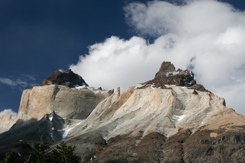

Whereas Torres del Paine are the Towers of Blue, Los Cuernos del Paine are the Horns of Blue. Somehow after the Torres, the Cuernos failed to impress and the French Valley felt like a slight disappointment. Perhaps, we felt that way because of Nic's fall.
|
|
|
Dinner that evening was nothing like Coté's treat, but we had a great time and felt relieved to have come back in one piece. The weather had been merciful to us these two crucial nights of camping, and it didn't rain at all until the morning. The plan was to see Gray Glacier in the morning, and the few hardcore and brave enough to venture there in the strongest winds yet came back to tell us that they could barely see the glacier due to the poor conditions. I was glad to have stayed behind. Again we packed up our sleeping bags, and at one o'clock lined up at the boat dock for our trip back to Puerto Natales and the comforts of a hot shower. |
|
|
| |


